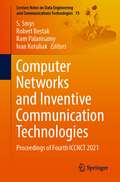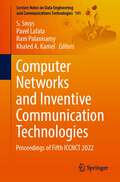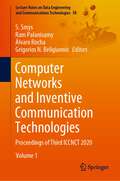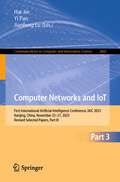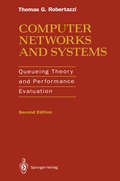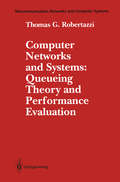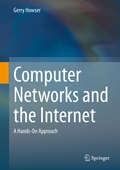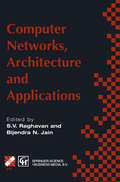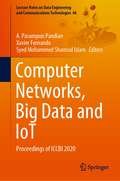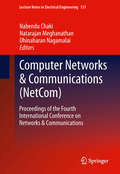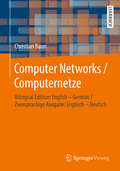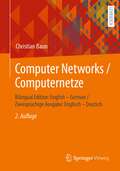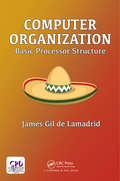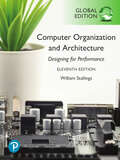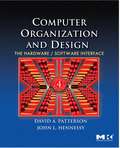- Table View
- List View
Computer Networks: A Systems Approach (ISSN)
by Larry L. Peterson Bruce S. DavieComputer Networks, Fourth Edition, continues to provide an enduring, practical understanding of networks and their building blocks through rich, example-based instruction. This expanded and completely updated edition covers the why of network design, focusing not just the specifications comprising today's systems but how key technologies and protocols actually work in the real world to solve specific problems. It is the only introductory computer networking book written by authors who have had first-hand experience with many of the protocols discussed in the text, who have actually designed some of them as well, and who are still actively designing the computer networks today. The book makes less use of computer code to explain protocols than earlier editions. Moreover, this new edition shifts the focus somewhat higher in the protocol stack where there is generally more innovative and exciting work going on at the application and session layers than at the link and physical layers. Other new features are: increased accessibility by clearly separating the advanced material from more fundamental via special headings and boxed features; the material is structured in such a way as to make it easier to teach top-down. Furthermore, the book outstrips the competitors in offering a more robust ancillary package for student and instructor support. The text is complemented with figures as well as links to networking resources on the Web and links to author-created materials on author-maintained Web site. Computer Networks, Fourth Edition, will be an invaluable resource for networking professionals and upper level undergraduate and graduate students in CS, EE, and CSE programs. Completely updated with new sidebar discussions that cover the deployment status of protocols described in the book.Addition of sizeable number of new exercises and solutions.
Computer Networks and Distributed Systems: International Symposium, CNDS 2013, Tehran, Iran, December 25-26, 2013, Revised Selected Papers (Communications in Computer and Information Science #428)
by Amir Hossein Jahangir Ali Movaghar Hossein AsadiThis book constitutes the refereed proceedings of the International Symposium on Computer Networks and Distributed Systems, CNDS 2013, held in Tehran, Iran, in December 2013. The 14 full papers presented were carefully reviewed and selected from numerous submissions. They are organized in topical sections such as cognitive and multimedia networks; wireless sensor networks; security; clouds and grids.
Computer Networks and Information Technologies: Second International Conference on Advances in Communication, Network, and Computing, CNC 2011, Bangalore, India, March 10-11, 2011. Proceedings (Communications in Computer and Information Science #142)
by Vinu V. Das Janahanlal Stephen Yogesh ChabaThis book constitutes the refereed proceedings of the Second International Conference on Advances in Communication, Network, and Computing, CNC 2011, held in Bangalore, India, in March 2011. The 41 revised full papers, presented together with 50 short papers and 39 poster papers, were carefully reviewed and selected for inclusion in the book. The papers feature current research in the field of Information Technology, Networks, Computational Engineering, Computer and Telecommunication Technology, ranging from theoretical and methodological issues to advanced applications.
Computer Networks and Intelligent Computing: 5th International Conference on Information Processing, ICIP 2011, Bangalore, India, August 5-7, 2011. Proceedings (Communications in Computer and Information Science #157)
by K. R. Venugopal L. M. PatnaikThis book constitutes the refereed proceedings of the 5th International Conference on Information Processing, ICIP 2011, held in Bangalore, India, in August 2011. The 86 revised full papers presented were carefully reviewed and selected from 514 submissions. The papers are organized in topical sections on data mining; Web mining; artificial intelligence; soft computing; software engineering; computer communication networks; wireless networks; distributed systems and storage networks; signal processing; image processing and pattern recognition.
Computer Networks and Inventive Communication Technologies: Proceedings of Fourth ICCNCT 2021 (Lecture Notes on Data Engineering and Communications Technologies #75)
by S. Smys Robert Bestak Ram Palanisamy Ivan KotuliakThis book is a collection of peer-reviewed best-selected research papers presented at 4th International Conference on Computer Networks and Inventive Communication Technologies (ICCNCT 2021). The book covers new results in theory, methodology, and applications of computer networks and data communications. It includes original papers on computer networks, network protocols and wireless networks, data communication technologies, and network security. The proceedings of this conference are a valuable resource, dealing with both the important core and the specialized issues in the areas of next-generation wireless network design, control, and management, as well as in the areas of protection, assurance, and trust in information security practice. It is a reference for researchers, instructors, students, scientists, engineers, managers, and industry practitioners for advanced work in the area.
Computer Networks and Inventive Communication Technologies: Proceedings of Fifth ICCNCT 2022 (Lecture Notes on Data Engineering and Communications Technologies #141)
by S. Smys Pavel Lafata Ram Palanisamy Khaled A. KamelThis book is a collection of peer-reviewed best selected research papers presented at 5th International Conference on Computer Networks and Inventive Communication Technologies (ICCNCT 2022). The book covers new results in theory, methodology, and applications of computer networks and data communications. It includes original papers on computer networks, network protocols and wireless networks, data communication technologies, and network security. The proceedings of this conference is a valuable resource, dealing with both the important core and the specialized issues in the areas of next generation wireless network design, control, and management, as well as in the areas of protection, assurance, and trust in information security practice. It is a reference for researchers, instructors, students, scientists, engineers, managers, and industry practitioners for advance work in the area.
Computer Networks and Inventive Communication Technologies: Proceedings of Third ICCNCT 2020 (Lecture Notes on Data Engineering and Communications Technologies #58)
by S. Smys Ram Palanisamy Álvaro Rocha Grigorios N. BeligiannisThis book is a collection of peer-reviewed best selected research papers presented at 3rd International Conference on Computer Networks and Inventive Communication Technologies (ICCNCT 2020). The book covers new results in theory, methodology, and applications of computer networks and data communications. It includes original papers on computer networks, network protocols and wireless networks, data communication technologies, and network security. The proceedings of this conference is a valuable resource, dealing with both the important core and the specialized issues in the areas of next generation wireless network design, control, and management, as well as in the areas of protection, assurance, and trust in information security practice. It is a reference for researchers, instructors, students, scientists, engineers, managers, and industry practitioners for advance work in the area.
Computer Networks and IoT: First International Artificial Intelligence Conference, IAIC 2023, Nanjing, China, November 25–27, 2023, Revised Selected Papers, Part III (Communications in Computer and Information Science #2060)
by Hai Jin Yi Pan Jianfeng LuThis 3-volume set, CCIS 2058-2060 constitutes the First International Conference, on Artificial Intelligence, IAIC 2023, held in Nanjing, China, in November 2023. The 85 full papers presented were carefully reviewed and selected from 428 submissions. The papers are clustered in parts on: Artificial Intelligence and Machine Learning; Data Security and information Security; Computer Networks and IoT. The papers present recent research and developments in artificial intelligence and its applications in machine learning, natural language processing, computer vision, robotics, and ethical considerations.
Computer Networks and Systems: Queueing Theory and Performance Evaluation
by Thomas G. RobertazziStatistical performance evaluation has assumed an increasing amount of im portance as we seek to design more and more sophisticated communication and information processing systems. The ability to predict a proposed system's performance without actually having to construct it is an extremely cost effec tive design tool. This book is meant to be a first-year graduate level introduction to the field of statIstical performance evaluation. As such, it covers continuous time queueing theory (chapters 1-4), stochastic Petri networks (chapter 5), and discrete time queueing theory (chapter 6). There is a short appendix at the end of the book that reviews basic probability theory. At Stony Brook, this mate rial would be covered in the second half of a two course sequence (the first half is an applied computer networks course). Students seem to be encouraged to pursue the analytical material of this book if they first have some idea of the potential applications.
Computer Networks and Systems: Queueing Theory and Performance Evaluation (Telecommunication Networks and Computer Systems)
by Thomas G. RobertazziStatistical performance evaluation has assumed an increasing amount of importance as we seek to design more and more sophisticated communi cation and information processing systems. The ability to predict a pro posed system's performance without actually having to construct it is an extremely cost effective design tool. This book is meant to be a first year graduate level introduction to the field of statistical performance evaluation. As such, it covers queueing theory (chapters 1-4) and stochastic Petri networks (chapter 5). There is a short appendix at the end of the book which reviews basic probability theory. At Stony Brook, this material would be covered in the second half of a two course sequence (the first half is a computer networks course using a text such as Schwartz's Telecommunications Networks). Students seem to be encouraged to pursue the analytical material of this book if they first have some idea of the potential applications. I am grateful to B.L. Bodnar, J. Blake, J.S. Emer, M. Garrett, W. Hagen, Y.C. Jenq, M. Karol, J.F. Kurose, S.-Q. Li, A.C. Liu, J. McKenna, H.T. Mouftah and W.G. Nichols, I.Y. Wang, the IEEE and Digital Equip ment Corporation for allowing previously published material to appear in this book.
Computer Networks and the Internet: A Hands-On Approach
by Gerry HowserThe goal of this textbook is to provide enough background into the inner workings of the Internet to allow a novice to understand how the various protocols on the Internet work together to accomplish simple tasks, such as a search. By building an Internet with all the various services a person uses every day, one will gain an appreciation not only of the work that goes on unseen, but also of the choices made by designers to make life easier for the user.Each chapter consists of background information on a specific topic or Internet service, and where appropriate a final section on how to configure a Raspberry Pi to provide that service.While mainly meant as an undergraduate textbook for a course on networking or Internet protocols and services, it can also be used by anyone interested in the Internet as a step–by–step guide to building one's own Intranet, or as a reference guide as to how things work on the global Internet
Computer Networks, Architecture and Applications: Proceedings of the IFIP TC6 conference 1994 (IFIP Advances in Information and Communication Technology)
by R. V. Raghavan B. N. JainComputer Networks, Architecture and Applications covers many aspects of research in modern communications networks for computing purposes.
Computer Networks, Big Data and IoT: Proceedings of ICCBI 2020 (Lecture Notes on Data Engineering and Communications Technologies #66)
by A. Pasumpon Pandian Xavier Fernando Syed Mohammed Shamsul IslamThis book presents best selected research papers presented at the International Conference on Computer Networks, Big Data and IoT (ICCBI 2020), organized by Vaigai College Engineering, Madurai, Tamil Nadu, India, during 15–16 December 2020. The book covers original papers on computer networks, network protocols and wireless networks, data communication technologies and network security. The book is a valuable resource and reference for researchers, instructors, students, scientists, engineers, managers and industry practitioners in those important areas.
Computer Networks & Communications: Proceedings of the Fourth International Conference on Networks & Communications (Lecture Notes in Electrical Engineering #131)
by Nabendu Chaki, Natarajan Meghanathan and Dhinaharan NagamalaiComputer Networks & Communications (NetCom) is the proceedings from the Fourth International Conference on Networks & Communications. This book covers theory, methodology and applications of computer networks, network protocols and wireless networks, data communication technologies, and network security. The proceedings will feature peer-reviewed papers that illustrate research results, projects, surveys and industrial experiences that describe significant advances in the diverse areas of computer networks & communications.
Computer Networks / Computernetze: Bilingual Edition: English – German / Zweisprachige Ausgabe: Englisch – Deutsch
by Christian BaunMit diesem Buch erlangen Sie Grundlagenwissen im Bereich der ComputernetzwerkeDieses Buch bietet Ihnen einen kompakten Überblick über das Thema Computernetzwerke. Sein Aufbau orientiert sich an den Schichten der etablierten Referenzmodelle und behandelt für jede Schicht die Geräte und die wichtigsten Protokolle. Zu den Protokollen gehören auch Netzwerktechnologien wie Ethernet, WLAN, Bluetooth usw. und die Übertragungsmedien.Das Ziel des Buches ist es nicht, eine Auflistung von Algorithmen zu schaffen, sondern eine an der Realität orientierte Beschreibung zu liefern, die die wichtigsten Technologien in einem klaren Zusammenhang behandelt. Das Buch soll dem Leser ein fundiertes Verständnis von Computernetzwerken in kompakter Form vermitteln.Das Besondere dabei ist die zweisprachige Darstellung des Inhalts. In zwei Spalten stehen der deutsche und der englische Text nebeneinander, so dass der Leser gleichzeitig seine Sprachkenntnisse und sein Fachvokabular verbessern kann. Das Buch richtet sich vor allem an Studierende der Informatik und an alle am Thema Interessierten. Diese Inhalte vermittelt der Autor dem LeserChristian Baun vermittelt dem Leser in seinem Buch alle wichtigen Grundlagen der Computernetzwerke. Dazu gehören unter anderen:· Grundlagen der Informations- und Netzwerktechnik· Grundlagen der Computervernetzung· Protokolle und Protokollschichten· Bitübertragungsschicht· Sicherungsschicht· Vermittlungsschicht· Transportschicht· Anwendungsschicht· Netzwerkvirtualisierung· Funktionsweise des OSI-Referenzmodells· Kommandozeilenwerkzeuge Mithilfe dieser Inhalte erhält der Leser einen kompakten Einblick in die Thematik.---This book presents a compact, yet detailed overview and introduction to computer networks and their components. The book is written in both English and German, arranged in side-by-side columns. This feature helps readers improve and broaden their language skills, and gain familiarity with the specialized vocabulary of computer science and networking at the same time. The book opens with a review of computer science basics, including the building blocks of data, file and storage dimensions, and Unicode. The fundamentals of computer networking are presented, with sections on the dimensions of different types of networks, data transmission, and media access control. Protocols and reference models are explained, followed by chapters on the functional layers of networks: Physical Layer, Data Link Layer, Network Layer, Transport Layer, and Application Layer. Additional topics covered include:· Computer network topologies· Bandwidth and latency· Network virtualization The book includes a collection of command line tools for network configuration and for analyzing network-related issues. The book concludes with a list of technical terms, and an extensive glossary, both presented in side-by-side columns, in English and German. Requiring little to no technical background, Computer Networks – Computernetze benefits college-level students interested in computer science. It is especially useful for students and working professionals who wish to improve their knowledge of networks and to gain greater comprehension of the technical language of computing in either German or English.
Computer Networks / Computernetze: Bilingual Edition: English – German / Zweisprachige Ausgabe: Englisch – Deutsch
by Christian BaunMit diesem Buch erlangen Sie Grundlagenwissen im Bereich der ComputernetzwerkeDieses Buch bietet Ihnen einen kompakten Überblick über das Thema Computernetzwerke. Sein Aufbau orientiert sich an den Schichten der etablierten Referenzmodelle und behandelt für jede Schicht die Geräte und die wichtigsten Protokolle. Zu den Protokollen gehören auch Netzwerktechnologien wie Ethernet, WLAN, Bluetooth usw. und die Übertragungsmedien.Das Ziel des Buches ist es nicht, eine Auflistung von Algorithmen zu schaffen, sondern eine an der Realität orientierte Beschreibung zu liefern, die die wichtigsten Technologien in einem klaren Zusammenhang behandelt. Das Buch soll dem Leser ein fundiertes Verständnis von Computernetzwerken in kompakter Form vermitteln.Das Besondere dabei ist die zweisprachige Darstellung des Inhalts. In zwei Spalten stehen der deutsche und der englische Text nebeneinander, so dass der Leser gleichzeitig seine Sprachkenntnisse und sein Fachvokabular verbessern kann. Das Buch richtet sich vor allem an Studierende der Informatik und an alle am Thema Interessierten. Diese Inhalte vermittelt der Autor dem LeserChristian Baun vermittelt dem Leser in seinem Buch alle wichtigen Grundlagen der Computernetzwerke. Dazu gehören unter anderen:· Grundlagen der Informations- und Netzwerktechnik· Grundlagen der Computervernetzung· Protokolle und Protokollschichten· Bitübertragungsschicht· Sicherungsschicht· Vermittlungsschicht· Transportschicht· Anwendungsschicht· Netzwerkvirtualisierung· Funktionsweise des OSI-Referenzmodells· Kommandozeilenwerkzeuge Mithilfe dieser Inhalte erhält der Leser einen kompakten Einblick in die Thematik.---This book presents a compact, yet detailed overview and introduction to computer networks and their components. The book is written in both English and German, arranged in side-by-side columns. This feature helps readers improve and broaden their language skills, and gain familiarity with the specialized vocabulary of computer science and networking at the same time. The book opens with a review of computer science basics, including the building blocks of data, file and storage dimensions, and Unicode. The fundamentals of computer networking are presented, with sections on the dimensions of different types of networks, data transmission, and media access control. Protocols and reference models are explained, followed by chapters on the functional layers of networks: Physical Layer, Data Link Layer, Network Layer, Transport Layer, and Application Layer. Additional topics covered include:· Computer network topologies· Bandwidth and latency· Network virtualization The book includes a collection of command line tools for network configuration and for analyzing network-related issues. The book concludes with a list of technical terms, and an extensive glossary, both presented in side-by-side columns, in English and German. Requiring little to no technical background, Computer Networks – Computernetze benefits college-level students interested in computer science. It is especially useful for students and working professionals who wish to improve their knowledge of
Computer Networks ISE: A Systems Approach (ISSN)
by Larry L. Peterson Bruce S. DavieComputer Networks ISE, Fourth Edition, is the only introductory computer networking book written by authors who have had first-hand experience with many of the protocols discussed in the book, who have actually designed some of them as well, and who are still actively designing the computer networks today. This newly revised edition continues to provide an enduring, practical understanding of networks and their building blocks through rich, example-based instruction. The authors' focus is on the why of network design, not just the specifications comprising today's systems but how key technologies and protocols actually work in the real world to solve specific problems. The new edition makes less use of computer code to explain protocols than earlier editions. Moreover, this new edition shifts the focus somewhat higher in the protocol stack where there is generally more innovative and exciting work going on at the application and session layers than at the link and physical layers.Completely updated with NEW sidebars discussing successes/failures of previously deployed networksThorough companion website with downloadable OpNet network simulation software and lab experiments manualExpanded coverage of topics of utmost importance to today's networking professionals, e.g., security, wireless, multimedia applications
Computer Organisation and Architecture: Evolutionary Concepts, Principles, and Designs
by Pranabananda ChakrabortyComputer organization and architecture is becoming an increasingly important core subject in the areas of computer science and its applications, and information technology constantly steers the relentless revolution going on in this discipline. This textbook demystifies the state of the art using a simple and step-by-step development from traditional fundamentals to the most advanced concepts entwined with this subject, maintaining a reasonable balance among various theoretical principles, numerous design approaches, and their actual practical implementations. Being driven by the diversified knowledge gained directly from working in the constantly changing environment of the information technology (IT) industry, the author sets the stage by describing the modern issues in different areas of this subject. He then continues to effectively provide a comprehensive source of material with exciting new developments using a wealth of concrete examples related to recent regulatory changes in the modern design and architecture of different categories of computer systems associated with real-life instances as case studies, ranging from micro to mini, supermini, mainframes, cluster architectures, massively parallel processing (MPP) systems, and even supercomputers with commodity processors. Many of the topics that are briefly discussed in this book to conserve space for new materials are elaborately described from the design perspective to their ultimate practical implementations with representative schematic diagrams available on the book’s website. Key Features Microprocessor evolutions and their chronological improvements with illustrations taken from Intel, Motorola, and other leading families Multicore concept and subsequent multicore processors, a new standard in processor design Cluster architecture, a vibrant organizational and architectural development in building up massively distributed/parallel systems InfiniBand, a high-speed link for use in cluster system architecture providing a single-system image FireWire, a high-speed serial bus used for both isochronous real-time data transfer and asynchronous applications, especially needed in multimedia and mobile phones Evolution of embedded systems and their specific characteristics Real-time systems and their major design issues in brief Improved main memory technologies with their recent releases of DDR2, DDR3, Rambus DRAM, and Cache DRAM, widely used in all types of modern systems, including large clusters and high-end servers DVD optical disks and flash drives (pen drives) RAID, a common approach to configuring multiple-disk arrangements used in large server-based systems A good number of problems along with their solutions on different topics after their delivery Exhaustive material with respective figures related to the entire text to illustrate many of the computer design, organization, and architecture issues with examples are available online at http://crcpress.com/9780367255732 This book serves as a textbook for graduate-level courses for computer science engineering, information technology, electrical engineering, electronics engineering, computer science, BCA, MCA, and other similar courses.
Computer Organisation and Architecture: Evolutionary Concepts, Principles, and Designs
by Pranabananda ChakrabortyComputer organization and architecture is becoming an increasingly important core subject in the areas of computer science and its applications, and information technology constantly steers the relentless revolution going on in this discipline. This textbook demystifies the state of the art using a simple and step-by-step development from traditional fundamentals to the most advanced concepts entwined with this subject, maintaining a reasonable balance among various theoretical principles, numerous design approaches, and their actual practical implementations. Being driven by the diversified knowledge gained directly from working in the constantly changing environment of the information technology (IT) industry, the author sets the stage by describing the modern issues in different areas of this subject. He then continues to effectively provide a comprehensive source of material with exciting new developments using a wealth of concrete examples related to recent regulatory changes in the modern design and architecture of different categories of computer systems associated with real-life instances as case studies, ranging from micro to mini, supermini, mainframes, cluster architectures, massively parallel processing (MPP) systems, and even supercomputers with commodity processors. Many of the topics that are briefly discussed in this book to conserve space for new materials are elaborately described from the design perspective to their ultimate practical implementations with representative schematic diagrams available on the book’s website. Key Features Microprocessor evolutions and their chronological improvements with illustrations taken from Intel, Motorola, and other leading families Multicore concept and subsequent multicore processors, a new standard in processor design Cluster architecture, a vibrant organizational and architectural development in building up massively distributed/parallel systems InfiniBand, a high-speed link for use in cluster system architecture providing a single-system image FireWire, a high-speed serial bus used for both isochronous real-time data transfer and asynchronous applications, especially needed in multimedia and mobile phones Evolution of embedded systems and their specific characteristics Real-time systems and their major design issues in brief Improved main memory technologies with their recent releases of DDR2, DDR3, Rambus DRAM, and Cache DRAM, widely used in all types of modern systems, including large clusters and high-end servers DVD optical disks and flash drives (pen drives) RAID, a common approach to configuring multiple-disk arrangements used in large server-based systems A good number of problems along with their solutions on different topics after their delivery Exhaustive material with respective figures related to the entire text to illustrate many of the computer design, organization, and architecture issues with examples are available online at http://crcpress.com/9780367255732 This book serves as a textbook for graduate-level courses for computer science engineering, information technology, electrical engineering, electronics engineering, computer science, BCA, MCA, and other similar courses.
Computer Organisation and Architecture: An Introduction (Computer Science Series)
by B.S. ChalkThis text is intended for students taking single semester units on computer systems, architecture and computer systems technology as part of an HND or undergraduate course. It describes and illustrates how the hardware and software components that go to make up the computer and its environment are organised and interconnected, thereby providing an efficient machine capable of carrying out an extensive range of tasks. The author takes a bottom-up approach, beginning with logic gates and data representation and culminating in an analysis of RISC processors and parallel architectures. Not more than a basic knowledge of computer programming is assumed. Throughout the text, self test questions are included; each chapter also contains exercises, a summary and suggestions for further reading.
Computer Organisation and Architecture: An Introduction (Grassroots)
by B.S. Chalk Antony Carter Robert HindThis book describes how a computer works and explains how the various hardware components are organized and interconnected to provide a platform upon which programs can be executed. It takes a simple, step-by-step approach suitable for first year undergraduates coming to the subject for the first time. The second edition of this book has been thoroughly updated to cover new developments in the field and includes new diagrams and end-of-chapter exercises. It will also be accompanied by a lecturer and student web site which will contain solutions to exercises, further exercises, PowerPoint slides and all the source code used in the book.
Computer Organization: Basic Processor Structure (Routledge Essential Grammars Ser.)
by James Gil de LamadridComputer Organization: Basic Processor Structure is a class-tested textbook, based on the author’s decades of teaching the topic to undergraduate and beginning graduate students. The main questions the book tries to answer are: how is a processor structured, and how does the processor function, in a general-purpose computer? The book begins with a discussion of the interaction between hardware and software, and takes the reader through the process of getting a program to run. It starts with creating the software, compiling and assembling the software, loading it into memory, and running it. It then briefly explains how executing instructions results in operations in digit circuitry. The book next presents the mathematical basics required in the rest of the book, particularly, Boolean algebra, and the binary number system. The basics of digital circuitry are discussed next, including the basics of combinatorial circuits and sequential circuits. The bus communication architecture, used in many computer systems, is also explored, along with a brief discussion on interfacing with peripheral devices. The first part of the book finishes with an overview of the RTL level of circuitry, along with a detailed discussion of machine language. The second half of the book covers how to design a processor, and a relatively simple register-implicit machine is designed. ALSU design and computer arithmetic are discussed next, and the final two chapters discuss micro-controlled processors and a few advanced topics.
Computer Organization: Basic Processor Structure
by James Gil de LamadridComputer Organization: Basic Processor Structure is a class-tested textbook, based on the author’s decades of teaching the topic to undergraduate and beginning graduate students. The main questions the book tries to answer are: how is a processor structured, and how does the processor function, in a general-purpose computer? The book begins with a discussion of the interaction between hardware and software, and takes the reader through the process of getting a program to run. It starts with creating the software, compiling and assembling the software, loading it into memory, and running it. It then briefly explains how executing instructions results in operations in digit circuitry. The book next presents the mathematical basics required in the rest of the book, particularly, Boolean algebra, and the binary number system. The basics of digital circuitry are discussed next, including the basics of combinatorial circuits and sequential circuits. The bus communication architecture, used in many computer systems, is also explored, along with a brief discussion on interfacing with peripheral devices. The first part of the book finishes with an overview of the RTL level of circuitry, along with a detailed discussion of machine language. The second half of the book covers how to design a processor, and a relatively simple register-implicit machine is designed. ALSU design and computer arithmetic are discussed next, and the final two chapters discuss micro-controlled processors and a few advanced topics.
Computer Organization and Architecture, eBook [Global Edition]
by William StallingsSynopsis not available.
Computer Organization And Design: The Hardware/software Interface (PDF)
by David A. Patterson John L. HennessyThe best-selling computer organization book is thoroughly updated to provide a new focus on the revolutionary change taking place in industry today: the switch from uniprocessor to multicore microprocessors. This new emphasis on parallelism is supported by updates reflecting the newest technologies, with examples highlighting the latest processor designs and benchmarking standards. As with previous editions, a MIPS processor is the core used to present the fundamentals of hardware technologies, assembly language, computer arithmetic, pipelining, memory hierarchies and I/O. Sections on the ARM and x86 architectures are also included. Covers the revolutionary change from sequential to parallel computing, with a new chapter on parallelism and sections in every chapter highlighting parallel hardware and software topics. Includes a new appendix by the Chief Scientist and the Director of Architecture of NVIDIA covering the emergence and importance of the modern GPU, describing in detail for the first time the highly parallel, highly multithreaded multiprocessor optimized for visual computing. Describes a novel approach to measuring multicore performance--the "Roofline model"--with benchmarks and analysis for the AMD Opteron X4, Intel Xeon 5000, Sun UltraSPARC T2, and IBM Cell. Includes new content on Flash memory and Virtual Machines. Provides a large, stimulating set of new exercises, covering almost 200 pages. Features the AMD Opteron X4 and Intel Nehalem as real-world examples throughout the book. Updates all processor performance examples using the SPEC CPU2006 suite.




